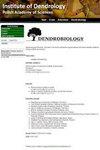斯洛伐克栎属间的种间分化和基因交换。栎类种群
IF 1.8
4区 农林科学
Q2 FORESTRY
引用次数: 1
摘要
众所周知,由于广泛的种间杂交和渗入,欧洲白橡树(Quercus section.Quercus)共享其细胞核和细胞质基因组的很大一部分。我们结合叶片形态计量学、中性核微卫星标记(nSSR)和潜在的适应性扩增片段长度多态性(AFLP),研究了分布在斯洛伐克的三个物种的自然种群,即粗壮Q.robur、petraea和毛Q。基于nSSR的种群结构贝叶斯分析表明,粗壮Q.的混合程度相对较低,而毛Q.和毛Q.的混杂程度较高。推断出的粗壮Q.祖先与基于13个叶片性状的典型判别分析的形态计量分数密切相关,而对于其他两个物种,这种相关性要弱得多。我们鉴定了两个与气候变量有关的AFLP片段,主要与起源地的空气蒸气压和温度状况特征有关。这些关联表明,气候适应是白栎种间分化和维持完整性的机制。本文章由计算机程序翻译,如有差异,请以英文原文为准。
Interspecific differentiation and gene exchange among the Slovak Quercus sect. Quercus populations
European white oak species (Quercus sect. Quercus) are known to share a substantial part of their nuclear and cytoplasmic genomes as a result of extensive interspecific hybridization and introgression. We studied natural populations of three species distributed in Slovakia, namely Q. robur, Q. petraea and Q. pubescens, which are largely sympatric but have contrasting ecological requirements, using a combination of leaf morphometry, neutral nuclear microsatellite markers (nSSR) and potentially adaptive amplified fragment length polymorphisms (AFLP). Bayesian analysis of population structure relying on nSSR revealed that the degree of admixture was relatively low in Q. robur but higher in Q. petraea and Q. pubescens. The inferred Q. robur ancestry closely correlated with morphometric scores of the canonical discriminant analysis based on 13 leaf traits, while for the other two species the correlation was much weaker. We identified two AFLP fragments associated with climatic variables, mainly with air vapour pressure and characteristics of temperature regime at the sites of origin. These associations indicate that climatic adaptation is the mechanism driving interspecific divergence and maintaining integrity of white oak species.
求助全文
通过发布文献求助,成功后即可免费获取论文全文。
去求助
来源期刊

Dendrobiology
农林科学-林学
CiteScore
2.20
自引率
11.10%
发文量
17
审稿时长
>12 weeks
期刊介绍:
Dendrobiology publishes original research articles and review articles related to the biology of trees and shrubs.
 求助内容:
求助内容: 应助结果提醒方式:
应助结果提醒方式:


